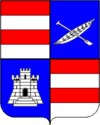Konavle
Konavle (pronounced [kɔ̌naːv̞lɛ]) is a municipality and a small region located southeast of Dubrovnik, Croatia.
Konavle | |
|---|---|
Municipality | |
| Općina Konavle Konavle Municipality | |
Location of Konavle within Dubrovnik-Neretva County | |
 Konavle The location of Konavle within Croatia | |
| Coordinates: 42°31′7″N 18°22′5″E | |
| Country | |
| County | Dubrovnik-Neretva County |
| Seat | Cavtat |
| Government | |
| • Mayor | Luka Korda (HDZ) |
| Area | |
| • Total | 209.97 km2 (81.07 sq mi) |
| Elevation | 0 m (0 ft) |
| Population (2011)[2] | |
| • Total | 8,577 |
| • Density | 41/km2 (110/sq mi) |
| Time zone | UTC+1 (CET) |
| • Summer (DST) | UTC+2 (CEST) |
| Postal code | 20 000 |
| Area code(s) | 020 |
| Licence plate | DU |
| Website | konavle.hr |
It is administratively part of the Dubrovnik-Neretva County and the center of the municipality is Cavtat.
Demographics
The total municipality population was 8,577 people in 2011, split in the following 32 settlements:[2]
- Brotnice, population 31
- Cavtat, population 2,153
- Čilipi, population 933
- Drvenik, population 52
- Duba Konavoska, population 63
- Dubravka, population 295
- Dunave, population 155
- Đurinići, population 96
- Gabrili, population 210
- Gruda, population 741
- Jasenice, population 14
- Komaji, population 275
- Kuna Konavoska, population 17
- Lovorno, population 183
- Ljuta, population 194
- Mihanići, population 96
- Mikulići, population 88
- Močići, population 447
- Molunat, population 212
- Palje Brdo, population 130
- Pločice, population 83
- Poljice, population 70
- Popovići, population 236
- Pridvorje, population 236
- Radovčići, population 228
- Stravča, population 60
- Šilješki, population 22
- Uskoplje, population 136
- Vitaljina, population 211
- Vodovađa, population 190
- Zastolje, population 150
- Zvekovica, population 570
In the 2011 census, 97.1% of the population were Croats.[3] Historically, inhabitants of Konavle were called Canalesi.[4]
History
Government of Dubrovnik in 1427 eradicate Bogomilism in Konavle and acted as in Pelješac when they expelled the Orthodox priests. Catholicism to Konavle was restored with Franciscans. Restoration of Catholicism was so rapid and efficient that at the end of the Middle Ages only Catholics lived there.[5] Even though considerably damaged during the Croatian War of Independence, Konavle maintain its status as one of the wealthiest counties in all of Croatia, consistently ranking amongst the ten richest counties.
Geography
Konavle is actually a narrow field located between the Sniježnica mountain and the Adriatic Sea, spanning the area from the coastal town of Cavtat to the Montenegrin border at Prevlaka. Other than Cavtat, only the southernmost village of Molunat is located on the coast, while the other 30 villages are in the hinterland.
The Sniježnica peak at 1234 meters of altitude is the highest point of the Dubrovnik-Neretva County and village of Kuna with its 700 m altitude is the highest village in the county. Although Gruda is the administrative center of the municipality, the largest settlement is Cavtat.
Transport
The airport for Dubrovnik is located near the Konavle village of Čilipi.
Notable people from Konavle
- Tereza Kesovija, singer
- Vlaho Bukovac, painter
- Frano Supilo, politician
- Baltazar Bogišić, jurist & legal historian
- Ivan Gundulić, poet, Konavle Count.
- Anton Perich, artist, filmmaker, poet
References
- "Općine na područjima posebne državne skrbi Republike Hrvatske" (PDF). Croatian Chamber of Economy. Retrieved 15 April 2020.
- "Population by Age and Sex, by Settlements, 2011 Census: Konavle". Census of Population, Households and Dwellings 2011. Zagreb: Croatian Bureau of Statistics. December 2012.
- "Population by Ethnicity, by Towns/Municipalities, 2011 Census: County of Dubrovnik-Neretva". Census of Population, Households and Dwellings 2011. Zagreb: Croatian Bureau of Statistics. December 2012.
- William Miller, Ottoman Empire and Its Successors, 1801–1927, 3rd ed. (Cambridge University Press, 1936), p. 36.
- Zdenka Janeković Römer, 2005, Citizens, Inhabitants, Subjects, Foreigners, Heterodox in Medieval Dubrovnik, Građani, stanovnici, podanici, stranci, inovjerci u srednjovjekovnom Dubrovniku // Raukarov zbornik : zbornik u čast Tomislava Raukara / Budak, Neven, https://www.bib.irb.hr/268941 #page= 317-346, https://www.academia.edu/7621134/Gra%C4%91ani_stanovnici_podanici_stranci_inovjerci_u_srednjovjekovnom_Dubrovniku_Citizens_Inhabitants_Subjects_Foreigners_Heterodox_in_Medieval_Dubrovnik_ #page=13-16

